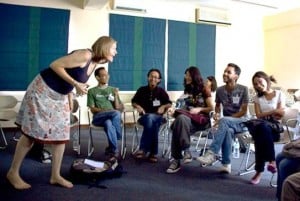 After visiting Nepal periodically since studying abroad there as an undergraduate, I returned on a Fulbright grant to work on a documentary photography project on beauty and body image in young women. I spent the next ten months interviewing and photographing my subjects, and although I worked independently, I still benefitted from a support network for encouragement and inspiration. Not long after returning to Nepal in September 2008, I began hearing about photo.circle—a community of photographers and photography enthusiasts, Nepali and bideshi or foreigners, that met monthly for photography viewings and discussion. In short order, I spent the first of what was to be many Saturday mornings in the company of a dynamic group of primarily young Nepalis who were engaged in multimedia storytelling and other creative pursuits.
After visiting Nepal periodically since studying abroad there as an undergraduate, I returned on a Fulbright grant to work on a documentary photography project on beauty and body image in young women. I spent the next ten months interviewing and photographing my subjects, and although I worked independently, I still benefitted from a support network for encouragement and inspiration. Not long after returning to Nepal in September 2008, I began hearing about photo.circle—a community of photographers and photography enthusiasts, Nepali and bideshi or foreigners, that met monthly for photography viewings and discussion. In short order, I spent the first of what was to be many Saturday mornings in the company of a dynamic group of primarily young Nepalis who were engaged in multimedia storytelling and other creative pursuits.
The connections I made through photo.circle helped propel my work in fascinating directions throughout my Fulbright year. I traveled with Kathmandu musicians to Palpa District in Western Nepal, where I spent a few days with a young woman who ran a beauty parlor. I visited Dhaka, Bangladesh, with a contingent of Nepali photographers for the biannual Chobi Mela International Photography Festival. I met another engaged group of creative storytellers at VENT! Magazine, and with them, I taught a two-day photojournalism workshop to about 15 Nepali photographers.
By the end of my grant year, when I had completed five multimedia stories on different women, I presented my work to the photo.circle community and engaged in a layered discussion on beauty and femininity with a packed house of Kathmanduites. Photo.circle was all that I was looking for and more: not only a supportive and inspirational community, but also a series of open doors that facilitated the growth of my project in unexpected and fulfilling ways. Beyond the scope of my work, photo.circle also introduced me to a number of Nepalis who would come to be great friends. I even helped introduce two friends who will marry in the coming year!
In all of this immersion into the community of Kathmandu artists, I began to think less and less of myself as an American among Nepalis, and more as photographer among other photographers. But I think the impetus for that was as much a reflection of how I was being treated by my Nepali friends and colleagues as it was how I felt about living in Nepal on my Fulbright grant. My Nepali slang had sharpened enough that I no longer needed constant translation for their colloquial shorthand, my Nepali friends were passing around the same viral YouTube videos that my friends back home would send me, and we were all updating our statuses and posting photos on Facebook (when not suffering from Kathmandu’s crippling rolling blackouts). Though we came from vastly different cultural upbringings, we looked to the same sources for creative inspiration and “geeked out” in eerily similar ways over technical achievements in Photoshop and FinalCutPro. As is often the lesson in cultural exchange, we were more alike than we were different (though they had decidedly better food).
Over a year earlier, back home in San Francisco, I spent three months researching and honing my Fulbright proposal; foregrounding the issue––beauty and body image––I was examining and stressing the contribution I would make to their domestic and international understanding. Though I will never know the specific reasons why I was awarded a Fulbright grant, I think one of my proposal’s strengths was the public nature of my proposed work. A journalistic project naturally lends itself well to projecting an issue into the public discourse that allows for meaningful cultural exchange. And while every project need not become journalistic, nor every journalistic project be funded, an application that includes a specific and organic avenue for sharing it with your community at home and abroad is likely to appear stronger. I was also able to craft a successful proposal because of my friends’ input. I sent a draft around to four or five people who gave me very specific feedback. I was able to incorporate their suggestions, such as restricting my project proposal to elements that were reasonable to achieve in a ten-month period because I began working on my proposal so far ahead of the deadline.
As I reflect back on my Fulbright experience of almost two years ago, I realize the most rewarding aspect of it was how unexpected it was. When I was preparing my Fulbright application, I never imagined myself connecting to a creative community in the way I would end up doing largely because I didn’t know one existed. But by following a tip from a few friends, my Fulbright experience transcended my original two-page proposal in more ways than I could have imagined.
Photo: Liz Lance, 2008-2009, Nepal, interacts with students during a photojournalism workshop she taught with VENT! Magazine in June 2009
Questions for Liz about her Fulbright experinces? Email her at LLance.AlumniAmbassador@fulbrightmail.org.

No Comments